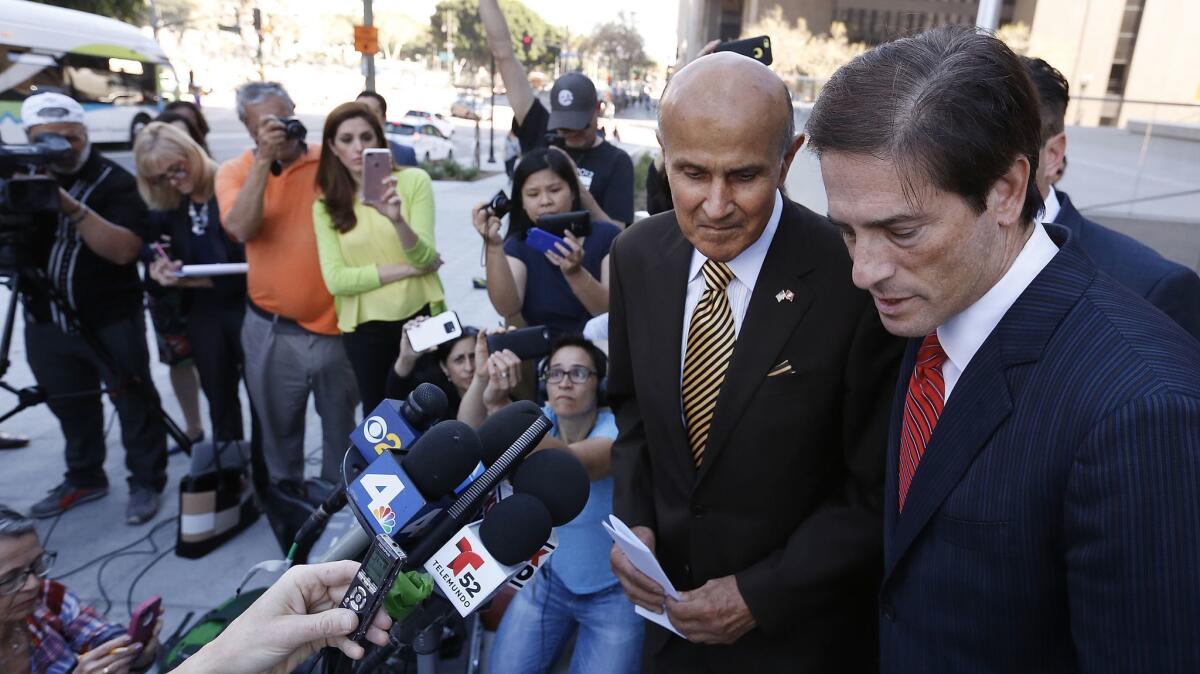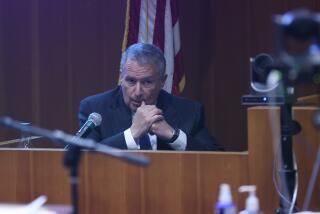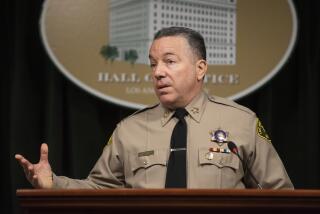Feds were near defeat in Lee Baca’s corruption case. But a ‘risky move’ in the ex-sheriff’s retrial turned the tide

- Share via
Before his retrial even began, Lee Baca was already losing.
In January, shortly after a jury had nearly acquitted the former Los Angeles County sheriff of charges that he helped obstruct an FBI investigation into abuses in his jails, Assistant U.S. Atty. Brandon Fox tipped his hand in a court filing. At the upcoming retrial, the prosecutor wrote, the government would not call several witnesses from the first trial who had testified that they tried to warn Baca about the inmate beatings and other corruption inside the county jails.
Fox was making a calculated move. Without the appearance of those witnesses, he told the judge, Baca’s defense attorney should be barred from presenting evidence of any “good acts” Baca did as sheriff to address problems in the jails.
The judge agreed.
The ruling received relatively little attention at the time. But the judge’s decision and other rulings that limited Baca’s defense had a dramatic impact on his retrial and are likely to be the focus of the former sheriff’s arguments as he seeks to appeal last week’s conviction.
Preventing evidence of “good acts” shut down a line of attack that Baca’s lawyer, Nathan Hochman, had used effectively in the first trial to counter the government’s portrayal of Baca as the Machiavellian head of the plot to obstruct the FBI. No longer could Hochman paint a different portrait of the man — that of an “open, direct, and transparent” sheriff who had no reason to interfere with a federal investigation because he was trying to fix the problems in his jails.
With Baca’s defense hamstrung, Fox’s team of public corruption prosecutors was freed up to take a chance by calling two former sheriff’s officials who were already convicted of playing central roles in the 2011 obstruction scheme. Calling the new witnesses posed serious risks: Their credibility would come under scathing attack from Hochman. But they had firsthand knowledge of Baca’s role in the plot — something jurors from the first trial had said was missing.
The tactical switch helped prosecutors win a conviction that appeared highly unlikely after the first jury deadlocked 11-1 in favor of acquitting Baca, a powerful and celebrated law enforcement figure who built a reputation as an eccentric but progressive leader known for his campaign to provide education services for jail inmates.
The second jury needed less than two days to convict Baca of conspiracy, obstruction of justice and making false statements to federal officials.
“Absolutely, it was risky,” Fox said immediately after the verdict, describing his decision to jettison the witnesses from the first trial. “But we felt the benefits of focusing more of the case on Mr. Baca outweighed having that evidence come in.”
Hochman remain tight-lipped at the time about U.S. District Judge Percy Anderson’s pretrial ruling, which was one of several that blocked him from introducing evidence that could have helped Baca. In comments to reporters moments after the guilty verdict, however, the attorney did not hide his belief that Baca had been unfairly disadvantaged by the judge.
“We fought the good fight every day in court,” he said outside the downtown federal courthouse, site of the trial. “But the jury is only as good as the evidence it gets to consider. Here, the jury did not get to consider all of the evidence — but the appellate court will.”
In appealing the verdict, Baca’s legal team is likely to argue that the former sheriff was denied a fair trial by the many rulings Anderson made against him.
Baca, who is 74 and in the early stages of Alzheimer’s disease, now faces the likelihood of a federal prison sentence. Anderson is scheduled to sentence Baca on May 15 and has yet to decide whether he will allow him to remain free pending his appeal.
The decision to forgo what Fox referred to in court filings and hearings as the “notice witnesses” — people who had alerted Baca to the jail abuses — was part of a major overhaul the government undertook of its case between the two proceedings, said Miriam Krinsky, a former federal prosecutor who led a commission on violence in the county jails.
Krinsky also cited another key prosecution move — Fox’s decision to add a charge that Baca made false statements to the second trial. Before the first trial, the prosecutor had agreed with the judge’s suggestion that the false statements charge be tried separately, after a jury had decided on the conspiracy and obstruction allegations.
Absolutely, it was risky.
— Assistant U.S. Atty. Brandon Fox on his strategy for the retrial
The idea to divide the case in two stemmed from Baca’s diagnosis with Alzheimer’s. Hochman wanted a psychiatrist to testify that the disease could explain the lies Baca was accused of telling federal investigators about his involvement in the obstruction plan during a 2013 interview.
The judge and Fox worried that testimony about Baca’s failing health might bias jurors in favor of the former sheriff. Breaking the case in two seemed like a strategy that would benefit the government’s case, and Hochman opposed it at the time.
But the strategy also prevented Fox from making a potentially potent argument. Unable to mention the false statements, the government could not argue to jurors that Baca had lied in order to cover up his culpability in the obstruction.
For the retrial, Anderson agreed to include the false statement charge. But he also went a step further, granting Fox’s request to bar the psychiatrist from testifying on grounds that his testimony was speculative and could mislead jurors.
Taken together, those decisions and Anderson’s decision to prevent testimony about Baca’s attempts at reforms “fundamentally changed the trial,” Krinsky said.
In the first trial, Hochman elicited testimony from witnesses about Baca’s attempts to deal with excessive force in the jails and, more generally, a commitment to oversight of his department.
Among other things, they said, he ordered special training for deputies aimed at subduing unruly inmates with minimal force, cooperated with federal officials on another investigation into misconduct within the department, and created an independent watchdog office to oversee internal affairs investigations.
That positive testimony during the first trial was essentially replaced, in the retrial, with audio clips of a Baca interview with prosecutors, during which he claimed that he didn’t know that his subordinates were trying to obstruct the FBI.
“The jury heard definitive words from Lee Baca, and it was hard not to conclude that they were the words of someone who was straying from the truth,” Krinsky said. In the jury’s eyes, she added, “he went from someone trying to do the right thing to someone more interested in protecting himself and his department.”
Hochman strenuously opposed Fox’s bid to have the judge toss the testimony favorable to Baca from the second trial. In one filing, he said the government was trying to “distort and mislead the jury into believing that Mr. Baca essentially took no action...to deal with these horrific instances of inmate beatings.” Disallowing the testimony, the attorney argued, would unfairly prevent him from defending Baca against the government’s claims.
With few avenues left, Hochman called a single witness in Baca’s defense.
That witness, Michael Gennaco, had spent more than a decade as the head of the watchdog agency that oversaw the Sheriff’s Department. His testimony, however, was repeatedly cut short by Anderson, who ruled that Gennaco’s observations about his experiences were irrelevant to the case.
For more news on the federal courts in Southern California, follow @joelrubin on Twitter
ALSO
The rise and fall of Lee Baca, L.A. County’s onetime ‘Teflon Sheriff’
Judge throws out murder conviction, orders man released from custody after 32 years behind bars
UPDATES:
6:15 p.m.: This article was updated with information on Baca’s sentencing date.
More to Read
Sign up for Essential California
The most important California stories and recommendations in your inbox every morning.
You may occasionally receive promotional content from the Los Angeles Times.











